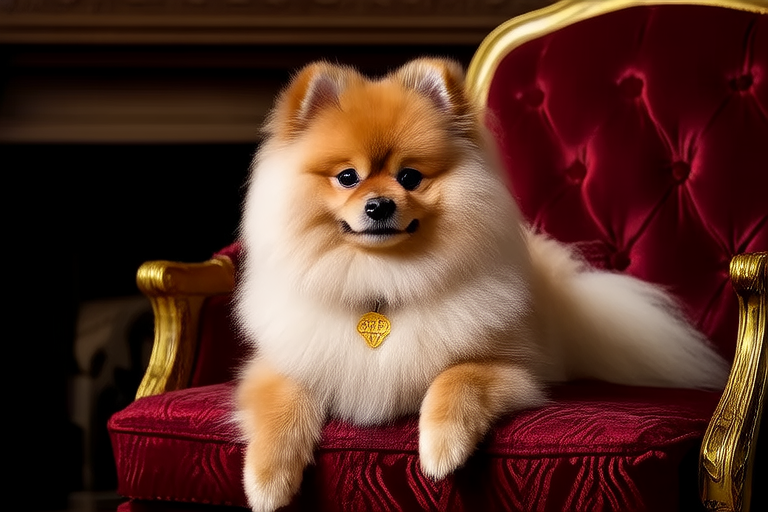Royal Canine Charm: The Majestic Legacy of the Pomeranian
The Pomeranian, a breed known for its small size, luxurious coat, and regal demeanor, has captured the hearts of dog lovers for centuries. This charming little dog, originally descended from the larger Spitz-type dogs, boasts a rich history that is intertwined with royalty and aristocracy. In this article, we will explore the origins of the Pomeranian, its rise in popularity among European nobility, its distinctive physical traits, temperament, and its role as a beloved companion in modern times.
Origins and Early History
The Pomeranian’s journey begins in the region of Pomerania, located in north-central Europe, which stretches across present-day Poland and Germany. These early ancestors were much larger than today’s Pomeranians, resembling the German Spitz. They were used for herding and guarding livestock. Over time, selective breeding led to the development of smaller versions of these dogs, eventually resulting in the diminutive yet mighty Pomeranian we know today.
The transition from working dogs to lapdogs began in the 18th century when these smaller breeds started to gain favor in royal courts. Queen Charlotte of Mecklenburg-Strelitz, who later became the wife of King George III of England, was one of the first to introduce Pomeranians to the British royal family. She owned a pair of Pomeranians named Misse and Juno, which she kept as cherished pets.
Rise in Popularity Among Royalty
The Pomeranian’s association with royalty reached its peak during the reign of Queen Victoria of England. Queen Victoria had a profound influence on the breed’s development and popularity. She fell in love with a small Pomeranian named Marco while visiting Italy in 1888. Marco, weighing only 3 pounds, was the smallest of the breed at the time. Upon returning to England, Queen Victoria became a devoted breeder and exhibitor of Pomeranians. She established the Pomeranian Club in 1891 and played a pivotal role in standardizing the breed’s appearance and characteristics.
Queen Victoria’s passion for Pomeranians inspired many other members of the royal family and aristocracy to adopt the breed. Her Majesty’s fondness for the breed is still celebrated today, and the legacy of her influence can be seen in the continued popularity of the Pomeranian as a companion animal.
Distinctive Physical Traits
The Pomeranian’s appearance is one of its most striking features. With their thick, double coats that come in a variety of colors, including orange, black, cream, and sable, these dogs are true fashionistas. Their coats are long and fluffy, often requiring regular grooming to maintain their luxurious appearance. Their expressive faces, with alert, almond-shaped eyes and perky ears, add to their charm and make them irresistible.
Pomeranians have a compact, sturdy build with a broad chest and a well-defined neck. Their tails are typically curled over their backs, adding to their overall elegance. Despite their small size, they possess a robust and lively disposition that belies their petite stature.
Temperament and Personality
Besides their striking looks, Pomeranians are known for their delightful personalities. They are intelligent, curious, and highly social dogs that thrive on attention and affection. Their loyalty and devotion to their human families make them ideal companions. However, due to their small size, they may sometimes exhibit a tendency towards bossiness or territorial behavior, especially around strangers or other animals.
Training a Pomeranian requires patience and consistency. Positive reinforcement techniques work best, as these dogs respond well to praise and treats. Socialization from an early age is essential to ensure they grow up to be well-rounded and confident adults. Early training also helps prevent any potential behavioral issues, such as excessive barking or aggression.
Modern-Day Roles as Companion Dogs
In contemporary society, Pomeranians continue to excel as loyal and loving companions. Their adaptability makes them suitable for both urban and rural environments, although they do require daily exercise to stay healthy and happy. A short walk or play session in the park is usually sufficient to meet their physical needs.
Despite their small size, Pomeranians are surprisingly resilient and can thrive in various living situations. They are particularly popular among older adults and individuals living in apartments, as they do not require extensive outdoor space. Their compact size and manageable energy levels make them perfect for those seeking a low-maintenance pet.
Care and Maintenance
Maintaining a Pomeranian’s coat requires regular brushing to prevent matting and tangling. Professional grooming every few months is recommended to keep their fur in top condition. Additionally, routine dental care, nail trimming, and ear cleaning are essential aspects of their overall health maintenance.
Dietary considerations are crucial for ensuring the well-being of your Pomeranian. High-quality dog food formulated for small breeds is ideal, providing the necessary nutrients to support their active lifestyle. Feeding them a balanced diet and monitoring their weight closely can help prevent obesity, which is common in this breed.
Anecdotes and Historical Facts
One notable anecdote involves Empress Maria Theresa of Austria, who owned a Pomeranian named Pudel. The Empress was so attached to Pudel that she carried him everywhere, even into important meetings. When Pudel passed away, the Empress commissioned a portrait of herself with her beloved dog, a testament to the deep bond between humans and their canine companions.
Another interesting fact is that Pomeranians were once considered the preferred breed for ladies of high society. Their small size and elegant appearance made them perfect traveling companions, and they were often carried in ornate carriers or baskets. This practice highlighted the status and wealth of their owners.
Conclusion
The Pomeranian’s journey from working dogs in northern Europe to beloved companions of royalty and aristocracy is a testament to their enduring appeal. Their distinctive appearance, charming personality, and adaptability have secured their place as one of the most cherished dog breeds worldwide. Whether you’re a seasoned dog lover or considering adopting your first pet, a Pomeranian could be the perfect addition to your family. With proper care, training, and attention, these magnificent little dogs will bring joy and companionship for years to come.
